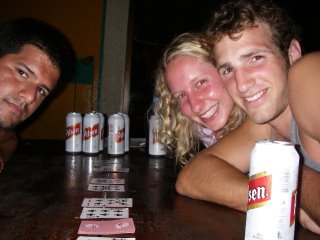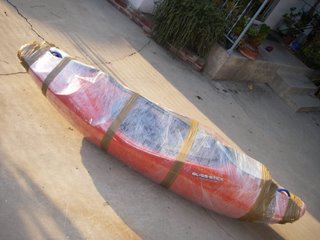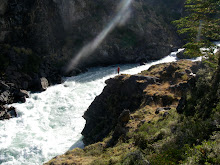The last 'Spin to Win' post had to do with spinning my mind, and cycling. This one is about spinning a different kind of wheel.
Driving in Costa Rica is pretty much insane. There are a number of different factors that contribute to this general level of insanity. First, its the laws and the lack of personnel to enforce them. Most of the traffic laws here are the same as in the states: Obey stop signs, yield, no passing zones, ect.. However they are all merely suggestions. There are very few traffic cops to enforce the laws, and most of the officers that are on the roads are easily bribed out of writing you a ticket. The tickets are inexpensive (16US$ for DUI), so there really is not much incentive to follow them.
Second, the drivers. The Costa Ricans are fanatical drivers. They must get where they are going as fast as possible using the path of least resistance. To this end, they will drive on sidewalks, in the wrong lanes, or create new lanes, if it will get them there faster. It is not uncommon to get passed by busses going uphill around blind corners on dirt roads on your left side on the shoulder!
Third, it is the poor quality of the roads that crisscross around and through the mountains and jungles that dot the Costa Rican landscape. Many of the roads are paved with many potholes, unpaved with many potholes, or are only roads by the virtue of the last 10 people who drove there to get around the person in front of them. This story is about this aspect of the Costa Rican driving experience.
I was at Centaura (my company's horse stables) this morning after flying the hot air balloon over the Jungle with Esteban. Some of the guys had gone to the upper field to bring back horses for the clients who were riding in the afternoon. I had just missed them, and Esteban suggested I take Rosita (Tucker's infamous red Land Cruiser) up to the upper pasture. I also took with me Danny (cause he knew where we were going), and Paul (cause he was caught in the crossfire). We started up the hill toward the field, and a lot of the ground was muddy... Not just muddy puddle muddy, but slippery red clay and muck muddy. Rosita slid a bit, but managed to cruise over the level but slippery ground. It was similar to driving on snow.
When we got to the hill, there was a trickle of reddish water coming down the hill along with the guys who went to get the horses. They didn't need our help, but we decided to go up to the upper pasture anyway, just to see it and check out the horses. As we began to climb the muddy road, the tires spun a bit as red clay shot out the bottom of the Land Cruiser. The road went up gradually with clay over rocks for a bit before turning sharply upward and around a corner, banked and graded to the left. The wheels began to spin out and the cruiser lost control and power I floored to climb the steeper section of road. The road was already rutted out from others spinning their wheels, and the mud splattered everywhere as I floored it, hoping to regain traction and make the move up the hill. The tires screeched and spun, but the car wasn't going any further up the hill. Disappointed that we'd have to walk the last 100m, I slowly rolled the car backwards down the hill. This is when gravity took over.
Next thing I knew, the car was sliding sideways across the road (remember, the road was graded). As the car slid hopelessly into the ditch I spun the tires, a last chance to save the car from the small streambed roadside. The car tilted sideways as the left tires dropped into the chasm. We were stuck. Very stuck. For more than an hour, the three of us stuffed anything we could find under the wheels to create traction, to no avail. Finally, we radioed back to base that we were going to need some help.
They came in force. Three guys, a Land Rover 4x4, and a lot of will. They began trying to climb the hill I was unable to. It was nerve racking watching their vehicle climb the same path, get stuck and then almost roll backwards into Rosita. They tried that at least 4 times before deciding that the car wouldn't climb the hill, period. This was encouraging because at least they couldn't climb it either! Watching them spin their wheels, I didn't feel quite as stupid about landing the car off the road. After an hour of wheel spinning, rubber burning, mud slinging, car pushing, people pulling fun in the mud, we decided on two things: 1) We couldn't do it, 2) The Land Rover was almost out of gas.
A few of us headed back for more fuel while two of the younger guys stayed with Rosita. Getting gas in Costa Rica is quite difficult. Stations are few and far in between. An hour and a half later when they returned with gas, Rosita followed close behind. After we left, the two younger guys (neither had drivers licenses) read the instruction manual on Rosita and figured out how to use the winch and positraction, two very useful tools when you are stuck in the mud. The kids were so proud of themselves, it was good to see such spirit. I will never live this one down with Tucker. It is part of the ritual. Every young, male, non-Costa Rican guide she has ever had has gotten the car stuck one way or another. At least I didn't roll it, crash it, or damage it in any sort of permanent way. Of course, I do have 5 more months...

 Three days before Christmas I was traversing San Jose through the central mall. The streets were packed with busy shoppers and peddlers selling their goods. It was the hustle and bustle that you might find the week before Christmas in the US as well.
Three days before Christmas I was traversing San Jose through the central mall. The streets were packed with busy shoppers and peddlers selling their goods. It was the hustle and bustle that you might find the week before Christmas in the US as well.












